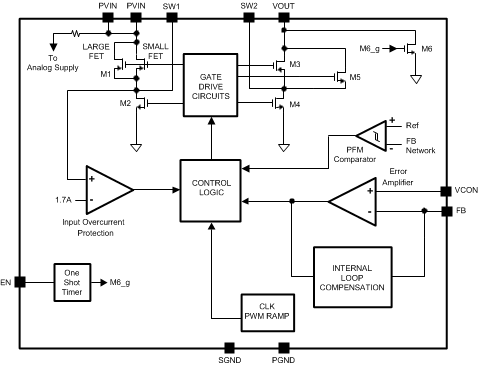SNVS793D November 2011 – May 2015 LM3269
PRODUCTION DATA.
- 1 Features
- 2 Applications
- 3 Description
- 4 Revision History
- 5 Pin Configuration and Functions
- 6 Specifications
- 7 Detailed Description
- 8 Application and Implementation
- 9 Power Supply Recommendations
- 10Layout
- 11Device and Documentation Support
- 12Mechanical, Packaging, and Orderable Information
7 Detailed Description
7.1 Overview
The LM3269 buck-boost converter provides high-efficiency, low-noise power for RF power amplifiers (PAs) in mobile phones, portable communicators, and similar battery-powered RF devices. It is designed to allow the RF PA to operate at maximum efficiency for a wide range of power levels from a single Li-Ion battery cell. The capability of the LM3269 to provide an output voltage lower than, as well as higher than, the input battery voltage enables the PA to operate with high linearity for a wide range of battery voltages, thereby extending the usable voltage range of the battery. The converter feedback loop is internally compensated for both buck and boost operation, and the architecture is such that it provides seamless transition between buck and boost modes of operation. The LM3269 operates in energy saving Pulse Frequency Modulation (PFM) mode for increased efficiencies and current savings during low-power RF transmission modes. The output voltage is dynamically programmable from 0.6 V to 4.2 V by adjusting the voltage on the control pin VCON without the need for external feedback resistors. The fast output voltage transient response of the LM3269 makes it suitable for adaptively adjusting the PA supply voltage depending on its transmitting power, which prolongs battery life.
Additional features include current overload protection, output overvoltage clamp, and thermal overload shutdown.
The LM3269 is constructed using a chip-scale 12-bump DSBGA package that offers the smallest possible size for space-critical applications such as cell phones, where board area is an important design consideration. Use of high switching frequency (2.4 MHz, typical) reduces the size of external components. As shown in the Typical Application Circuit, only three external power components are required for circuit operation. Use of DSBGA package requires special design considerations for implementation. (See DSBGA Package Assembly And Use) Its fine bump-pitch requires careful board design and precision assembly equipment. Use of this package is best suited for opaque-case applications where its edges are not subjected to high-intensity ambient red or infrared light. In addition, the system controller should set EN low during power-up and other low supply voltage conditions. (See Enable And Shutdown Mode.)
7.2 Functional Block Diagram

7.3 Feature Description
7.3.1 Dynamically Adjustable Output Voltage
The LM3269 features a dynamically adjustable output voltage to eliminate the need for external feedback resistors. The output can be set from 0.6 V to 4.2 V by changing the voltage on the analog VCON pin. This feature is useful in cell phone RF PA applications where peak power is needed only when the handset is far away from the base station or when data is being transmitted. In other instances, the transmitting power can be reduced; therefore the supply voltage to the PA can be reduced, promoting longer battery life. In order to adaptively adjust the supply voltage to the PA in real time in a cell-phone application, the output voltage transition should be fast enough to meet the RF transmit signal specifications. The LM3269 offers ultra-fast output voltage transition without drawing very large currents from the battery supply. For a current limit of 1700 mA (typical), the output voltage can transition from 1.4 V to 3 V in 10 µs with a load resistance of 11.4 Ω.
7.3.2 Seamless Buck Transition
The LM3269 features a unique internal power switch topology that improves converter efficiency, especially compared to typical non-inverting buck-boost converters. The LM3269 operates either as buck converter or a boost converter, depending upon the input and output voltage conditions. This creates a boundary between the buck and boost mode of operation. When the input battery voltage is close to the set output voltage, the converter automatically switches seamlessly such that the output voltage does not see any perturbations at the mode boundary. The excellent mode transition capability of the LM3269 enables low noise output with highest efficiency. Internal feedback loop compensation ensures stable operation in buck, boost and buck-boost mode transition operation.
7.3.3 Thermal Overload Protection
The LM3269 has a thermal overload protection function that operates to protect itself from short-term misuse and over-load conditions. When the junction temperature exceeds around 150°C, the device inhibits operation. All power MOSFET switches are turned off in PWM mode. When the temperature drops below 125°C, normal operation resumes. Prolonged operation in thermal overload conditions may damage the device and is considered bad practice.
7.4 Device Functional Modes
7.4.1 Enable And Shutdown Mode
Setting the EN digital pin low (< 0.6 V) places the LM3269 in shutdown mode (0.01 μA typical). During shutdown, the output of the LM3269 is tri-stated, maintaining charge storage on the output capacitor. Setting EN high (> 1.2 V) enables normal operation. EN should be set low to turn off the LM3269 during power up and undervoltage conditions when the power supply (PVIN) is less than the 2.7-V minimum operating voltage.
7.4.2 VCON,ON
The output is disabled when VCON is below 125 mV (typical). It is enabled when VCON is above 150 mV (typical). The threshold has approximately 25 mV (typical) of hysteresis.
7.4.3 Pulse Frequency Modulation (PFM) Mode
The LM3269 enters PFM mode and operates with reduced switching frequency and supply current to maintain very high efficiencies when the output voltage is less than 1.5 V. In PFM mode, the LM3269 will support up to 120 mA max. In PFM, if the output voltage exceeds 1.5 V, the device will automatically transition into a forced PWM mode of operation.